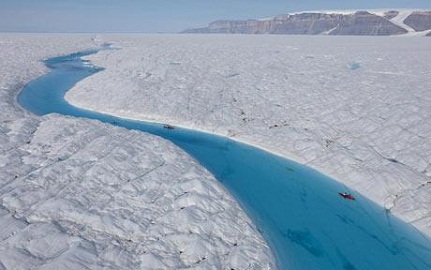Huge ice breaking in the North Pole
US scientists say an ice sheet of four times the size of Manhattan Island (260 km2) and a height of about 180m have been separated from the Petermann glacier in northern Greenland on Thursday morning (August 5).
This is the largest iceberg in the Arctic since 1962

Greenland's (Photo: EPA)
Andreas Muenchow, who led the research group at the University of Delaware, said: 'The amount of fresh water stored in this ice sheet can keep all public taps in the United States flowing continuously for 120 days . '
However, it is difficult to comment on whether this event was due to the impact of the Earth warming, because records of currents flowing around the glacier were only saved since 2003. .
It is known that ocean currents underneath glaciers are one of the main causes of the ice break in Greenland.
'Nobody can say this is due to the warming of the Earth. But on the contrary, it is not possible to confirm that this is not a consequence of the warming of the Earth , 'Mr. Muenchow said.
Scientists have recorded the first 6 months of 2010 as the hottest months of the earth for many years.The EI Nino weather phenomenon also contributes to the rise in temperature, but many scientists believe that the human-induced greenhouse effect has prompted higher temperatures.
Muenchow suggested that the newly released ice sheet could stop Nares Strait (about 992 kilometers south of the Arctic) if it drifted south, or broke into smaller blocks and headed to the Atlantic Ocean.
- The pole from the North of the Earth is ... shifting
- The north pole from the Earth is moving
- The pole from the North is moving to Russia
- How does the compass tell us where the North pole is at the South Pole?
- Video: Earth has 3 north poles
- The winter is prolonged due to the North Pole spiral moving
- Canada started drawing seabed maps around the North Pole
- Why did the North Pole move toward London?
- Marvel at unexpected discoveries about the North Pole
- The Earth core pushes from the North to 60 km per year
- The solar field is about to turn polar
- Detection of compressed air hot spots on the north pole of Saturn
 Is the magnetic North Pole shift dangerous to humanity?
Is the magnetic North Pole shift dangerous to humanity? Washington legalizes the recycling of human bodies into fertilizer
Washington legalizes the recycling of human bodies into fertilizer Lightning stone - the mysterious guest
Lightning stone - the mysterious guest Stunned by the mysterious sunset, strange appearance
Stunned by the mysterious sunset, strange appearance Plan to build giant canopy over Antarctica has problems
Plan to build giant canopy over Antarctica has problems  Why does ice stick to your hands when you hold it?
Why does ice stick to your hands when you hold it?  NASA releases ice map on Mars
NASA releases ice map on Mars  After 389 days in the Arctic, costing more than $160 million, hundreds of scientists brought back bad news: What was it?
After 389 days in the Arctic, costing more than $160 million, hundreds of scientists brought back bad news: What was it?  650,000-year-old 'gateway to the underworld' discovered in Siberia
650,000-year-old 'gateway to the underworld' discovered in Siberia  How to explain the strange ice circle that rotates like a time-travel door?
How to explain the strange ice circle that rotates like a time-travel door? 